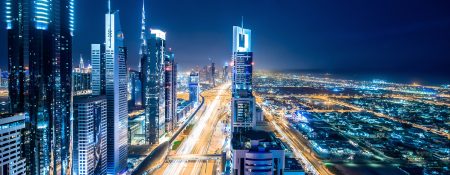This wonder of the modern world is planned to be tested somewhere in the end of 2022. The actual service is expected to be launched in 2023, preceded by a period of trials, digital maps building, stress-tests, and other routine procedures aimed at making this technology actually work.
UAE is ranked by global consultancy company KPMG as a country among the top in the world when it comes to readiness to integrate AI-operated driverless vehicles into the ultra-developed urban landscapes of such major cities, as Dubai and Abu Dhabi.
This new mode of transport became possible with the introduction of 5G, which enabled the devices and machines to communicate with each other and learn from their experiences at extremely high speeds.
In essence, all autonomous cars in one single fleet contribute to a shared knowledge base, which is used by each vehicle to learn from the collective experience. For example, if one vehicle sees that a certain road is closed, or there is a traffic congestion, all others will automatically try to avoid it.
Furthermore, automated Cruise cars are equipped with five high-precision laser sensors that detect fixed and moving objects, 16 cameras and 21 radars to perform three elements – Perception, Planning and Controls for safe autonomous driving.
In Perception, it “sees” using sensors to observe its environment. The sensors feed information to the computer that combines the sensor data with high-definition map data to localize the vehicle. It builds a 3D model of the world that keeps track of important elements.
Perception also predicts the future movement of objects – the movement of pedestrians and trucks are predicted differently. It identifies other environmental uncertainties like where it must look for moving objects. If its view is blocked, Perception will flag that area as unknown. If an object is hard to see because of rain or fog, or because it is hidden behind a truck, the computer brain knows that and adjusts its decision-making and performance accordingly.

Planning accounts for road rules and plans routes for the car to travel from trip origin to destination. It chooses routes to optimize efficiency and safety and to route the car only on streets within its capabilities. Planning identifies multiple paths per second, chooses the best one to meet changing road conditions.
Controls implements the final path from planning, giving the self-driving system full vehicle maneuverability complete with stability, traction and anti-lock brake systems fully active. When the vehicle detects rapid or abnormal changes in weather conditions, it will adjust how it operates to accommodate the weather and how other road users are behaving, such as when traffic slows during heavy rain. At all times, the fleet will communicate with a centralized fleet operations center.
As per Mattar Al Tayer, Director General of the RTA , “Human errors are responsible for more than 90 per cent of accidents. Autonomous vehicles are environmentally-friendly electric vehicles and can serve considerable numbers of customers, particularly senior citizens, residents and people of determination.”
The partnership agreement was signed per directives issued by Sheikh Hamdan bin Mohammed bin Rashid Al Maktoum, Crown Prince of Dubai and Chairman of the Executive Council.
His Highness Sheikh Mohamed bin Rashid Al Maktoum announced a goal that “by 2030, 25 per cent of all transportation trips in Dubai will be smart and driverless.”

